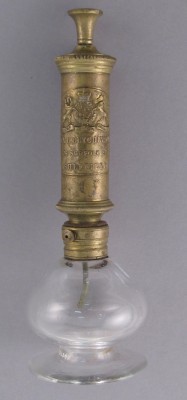Breast pump
| ACCESSION NUMBER: | 1941.5.1 a-b |
| Object Name: | Breast pump |
| Manufacturer: | W. & H. Hutchinson |
| Date Made: | 1800-1899 |
| MeSH Code: Medical Subject Headings | Breast Feeding; Milk, Human; Infant Food |
ARTEFACT DESCRIPTION
For centuries, mothers have used a number of different tools to relieve the pain of engorged breasts, correct inverted nipples, and increase milk production. Women in Ancient Greece used ceramic cups called gutti (dual purpose pumps and feeding bottles) to express milk. A mother would fill the cup with water, place it over her nipple and drain the water to create a weak vacuum that would force small amounts of milk out of the breast and into the cup. The Romans invented sucking glasses – glassware tools that worked like drinking straws. Mothers held the bulb end on their breasts while sucking on a long spout until milk was drawn out. Cups were not the only instruments available to help ease the discomfort of lactation. In the fifteenth century, women in many cultures were discouraged from feeding their children colostrum (the yellowish fluid that is produced a few days before and after childbirth, and before the milk). As a result, small dogs called whelps suckled mothers in order to get rid of the colostrum, while providing relief from the pressure and pain of full breasts. In order to provide children with food during this time, other women called wet nurses fed babies using their own fully formed milk.
The pump pictured here, used in Europe and North America in the nineteenth century, consists of a glass cup attached to a brass syringe. The open end of the cup was placed over the nipple and the plunger in the syringe pulled back to draw out the milk. An increase in American patents for breast pumps at this time suggests their popularity. These documents reveal a variety of different designs that ultimately create a vacuum or area of low pressure around a woman’s nipple. This action forces milk into a receptacle, where it can be collected by the user and stored for later use. Today, breast pumps still employ suction to express milk, but also mimic the sucking action of children, with suck-release-relax phases.
Related: Women; ‘Torture or Technology?’; Ideology & Knowledge
Reading List
1. Dowling, Donna A. “Lessons From the Past: A Brief History of the Influence of Social, Economic, and Scientific Factors on Infant Feeding.” Newborn and Infant Nursing Reviews 5 no. 1 (2005): 2-9.
2. Fildes, Valerie A. Breasts, Bottles and Babies: A History of Infant Feeding. Edinburgh: EdinburghUniversity Press, 1986.
3. Medela Incorporated, Breastfeeding Information Guide. McHenry, Illinois: Medela Incorporated, 1993.
4. Obladen, Michael. “Guttus, trialatte and téterelle: a history of breast pumps.” Journal of Prenatal Medicine 40 (2012): 669-675.







Leave a Reply